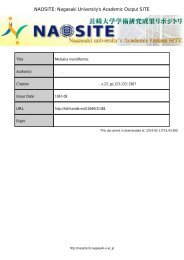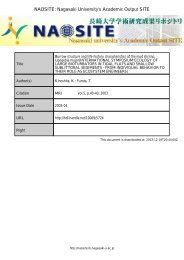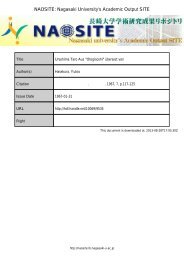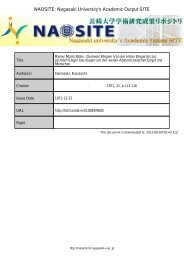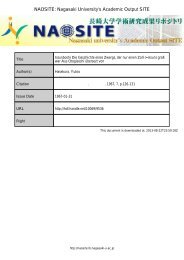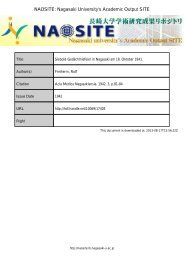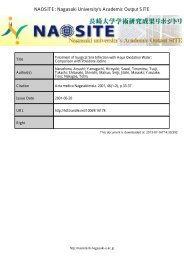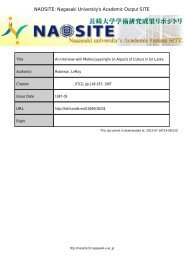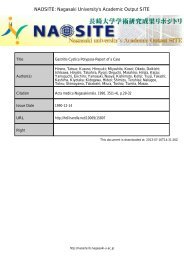Plankton Benthos Res. 6(3): 141-157 (2011)
Plankton Benthos Res. 6(3): 141-157 (2011)
Plankton Benthos Res. 6(3): 141-157 (2011)
Create successful ePaper yourself
Turn your PDF publications into a flip-book with our unique Google optimized e-Paper software.
<strong>Plankton</strong> <strong>Benthos</strong> <strong>Res</strong> 6(3): <strong>141</strong>–<strong>157</strong>, <strong>2011</strong><br />
<strong>Plankton</strong>ic ciliates below sea ice in Franklin Bay, Canada<br />
TOSHIKAZU SUZUKI 1, * & TAKASHI OTA 2<br />
1 Faculty of Fisheries, Nagasaki University, Nagasaki 852–8521, Japan<br />
2 Department of Biological Engineering, Ishinomaki Senshu University, Ishinomaki 986–8580, Japan<br />
Received 23 October 2010; Accepted 30 March <strong>2011</strong><br />
Abstract: <strong>Plankton</strong>ic ciliates below sea ice in Franklin Bay, Canada were studied in terms of their taxonomic composition<br />
and species descriptions. They occurred at an abundance of 2,400 cells L 1 and a biovolume of<br />
4.2410 6 mm 3 L 1 . Loricate ciliates (Tintinnida, Spirotrichea) occupied a very small percentage of the total both in<br />
terms of abundance (1.7%) and biovolume (1.9%). On the other hand, aloricate ciliates were predominant; in particular<br />
Myrionecta rubra (Cyclotrichida, Litostomatea) in terms of abundance (50%) and Lohmaniella oviformis<br />
(Choreotrichida, Spirotrichea) in terms of biomass (19.2%). Diagnoses and descriptions are given for ten aloricate<br />
species; eight of these species (Leegaardiella ovalis, Lohmaniella oviformis, Tontonia gracillima, Strombidium acutum,<br />
S. constrictum, S. dalum, S. epidemum, Myrionecta rubra) were identifiable in the present material. Compared with previous<br />
descriptions, six of these species (not S. constrictum or M. rubra) have more or less distinct characters incompatible<br />
with reported intraspecific variations.<br />
Key words: Franklin Bay, planktonic ciliates, sea ice, species description<br />
Introduction<br />
<strong>Plankton</strong>ic ciliates occur universally in the surface ocean<br />
and have been recognized as one of the important components<br />
in microbial food webs (e.g. Azam et al. 1983).<br />
Among the planktonic ciliates, aloricate forms are frequently<br />
predominant rather than tintinnid ciliates (e.g.<br />
Suzuki & Taniguchi 1998, Suzuki 1999). The former, however,<br />
have not been investigated globally especially from a<br />
faunistic viewpoint, because their taxonomic identification<br />
and morphological observations are generally laborious and<br />
time-consuming (Wilbert 1975, Montagnes & Lynn 1987).<br />
Furthermore, available criteria for their species identification<br />
are often insufficient for practical use, especially in<br />
small-sized species; descriptive information is limited and<br />
hence morphological variation in each species is not fully<br />
characterized compared with the situation in tintinnid ciliates.<br />
These difficulties prevent the development of further<br />
ecological studies on planktonic ciliates, such as population<br />
dynamics and studies of species diversity.<br />
Sea ice is observed in higher latitudes, especially in winter,<br />
in both hemispheres and covers up to 7% of the earth’s<br />
surface (Dieckmann & Hellmer 2003). It provides favorable<br />
habitats for ice algae and various consumers, especially<br />
* Corresponding author: Toshikazu Suzuki; E-mail, tsuzuki@nagasakiu.ac.jp<br />
<strong>Plankton</strong> & <strong>Benthos</strong><br />
<strong>Res</strong>earch<br />
© The <strong>Plankton</strong> Society of Japan<br />
around the boundary between the ice-bottom and the water<br />
column (Knox 1994, Schnack-Schiel 2003). Although<br />
planktonic ciliates may be an important component of the<br />
microbial fauna (Lizotte 2003), ecological information on<br />
them is extremely rare because the frigid climate is inhibitory<br />
for investigations. Fortunately, through a precious<br />
opportunity to collect planktonic ciliate specimens in icecovered<br />
Franklin Bay, Canada, it has become possible to<br />
offer here some basic information on ciliate ecology below<br />
sea ice.<br />
In this study, the taxonomic composition of planktonic<br />
ciliates dwelling below sea ice in Franklin Bay was investigated<br />
and detailed morphometrics of the dominant aloricate<br />
species were described to allow comparisons with previous<br />
descriptions. Furthermore, an attempt was made the biogeographic<br />
distribution of each aloricate species through<br />
referral to reliable articles published in the literature.<br />
Materials and Methods<br />
Sampling was carried out on 10 May 2004 at an overwintering<br />
station of CASES 2004 in Franklin Bay, Canada<br />
(70°02N, 126°18W; Fortier and Barber 2008). The water<br />
sample was collected with a Niskin-type water sampler at<br />
0.2 m depth below the sea ice (1.8 m thickness). Water temperature<br />
and salinity were simultaneously measured with a<br />
CTD (Sea-Bird 9). Chlorophyll a concentration was mea-
142 T. SUZUKI & T. OTA<br />
Fig. 1. Taxonomic compositions of planktonic ciliates that occurred below sea ice in Franklin Bay on 10 May 2004. Left circle<br />
is in terms of abundance and right one in biovolume. Numerals show percentage of each group. Sa: Strombidium acutum, Sc:<br />
Strombidium constrictum, Sd: Strombidium dalum, Se: Strombidium epidemum, Sci: Strombidium cf. inclinatum, Sct: Strombidium<br />
cf. taylori, Tg: Tontonia gracillima, u.: unidentified.<br />
sured by fluorometry after filtration of a 100 mL water subsample<br />
onto a GF/F filter (Parsons et al. 1984). Specimens<br />
in 650 mL were fixed with Bouin’s solution at a final concentration<br />
of 10%. After returning to the laboratory, ciliates<br />
were concentrated, impregnated and mounted with the quantitative<br />
protargol stain (QPS) method (Montagnes & Lynn<br />
1987), while the two steps for producing a purple-gray tone,<br />
placing in the gold chloride solution and the following oxalic<br />
acid solution, were omitted following the general protargol<br />
impregnation method (e.g. Wilbert 1975) to observe<br />
microstructures more clearly. Enumeration and observation<br />
were done under a light microscope with oil immersion<br />
lenses of 20, 40 and 100. For species descriptions, as<br />
many well-conditioned specimens, e.g. cell body not being<br />
damaged by fixation and staining of an appropriate tone for<br />
detailed observations as possible, were selected. Eight permanent<br />
slides, where all plankters that occurred in the 650<br />
mL sea water sample were stained with silver protein and<br />
mounted, without any missing, were deposited in the collection<br />
of the Faculty of Fisheries, Nagasaki University. Systematics<br />
is mainly according to Lynn & Small (2000).<br />
<strong>Res</strong>ults and Discussion<br />
Water temperature was 1.6°C and salinity was 30.7 psu.<br />
Chlorophyll a concentration was 0.53 mgL 1 . Among the<br />
autotrophic microplankton, diatoms were predominant<br />
(1.810 4 cells L 1 ), especially pennate types (78%).<br />
The standing crop of planktonic ciliates was 2,400 cells<br />
L 1 in terms of abundance and 4.2410 6 mm 3 L 1 in bio-<br />
volume without correcting for cell shrinkage due to Bouin’s<br />
fixation (Fig. 1). Ciliate/chlorophyll a ratio was 4,530<br />
cells mg 1 , which is in the higher half of the general range<br />
observed in the open ocean (100–10,000 cells mg 1 : Suzuki<br />
& Taniguchi 1998). Class Spirotrichea was predominant<br />
(81.2%) in terms of biovolume composition, while it was<br />
slightly subdominant (43.0%) to the class Litostomatea<br />
(54.1%) in terms of abundance. Among the spirotrich ciliates<br />
loricate forms (order Tintinnida) were a minor component<br />
(1.7% of abundance and 1.9% of biovolume); this subordinate<br />
tendency is the same as the general trend for the<br />
open ocean (Suzuki & Taniguchi 1998).<br />
Cell size of planktonic ciliates ranged from 7 to 33 mm in<br />
equivalent spherical diameter (ESD) for Bouin’s fixed specimens<br />
(Fig. 2): mean ESD was 13 mm and median was<br />
10 mm. Even when the cell diameter is corrected with a<br />
QPS shrinkage factor of 0.74, which is estimated from a<br />
factor of 0.4 ( 3 ø — 0.40.74) measured in terms of cell volume<br />
(Jerome et al. 1993), more than 70% of individuals belonged<br />
to the nanoplankton category (2–20 mm).<br />
Ten species were frequently observed and clearly identifiable:<br />
nine species belonged to the class Spirotrichea and<br />
the other to the class Litostomatea (Fig. 1). Descriptions of<br />
their morphology and other remarks, based on observations<br />
on their QPS specimens (Montagnes & Lynn 1987), are as<br />
follows.<br />
Class Spirotrichea Bütschli, 1889<br />
Subclass Choreotrichia Small & Lynn, 1985<br />
Order Choreotrichida Small & Lynn, 1985
Suborder Leegaardiellina Laval-Peuto, Grain and Deroux,<br />
1994<br />
Family Leegaardiellidae Lynn & Montagnes, 1988<br />
Genus Leegaardiella Lynn & Montagnes, 1988<br />
Leegaardiella ovalis Lynn & Montagnes, 1988 (Figs 3 &<br />
4, Table 1)<br />
Fig. 2. Relationship between cell size ranking (from small to<br />
large) and cell size (equivalent spherical diameter: ESD) of planktonic<br />
ciliates under sea ice in Franklin Bay. Two hundred and<br />
thirty four individuals were randomly selected and investigated.<br />
<strong>Plankton</strong>ic ciliates below sea ice 143<br />
Fig. 3. Schematic figures of protargol-stained Leegaardiella<br />
ovalis. a, lateral view showing external polykinetid zone (EPZ)<br />
and a macronucleus (Mn); b, anterior view showing EPZ base<br />
composed of two segments, two internal polykinetids (IPk) (3rd<br />
and 4th in counter clockwise order), supportive fibers (SF) and<br />
Mn; c, posterior view showing an arched somatic kinety (SK) and<br />
Mn; d, anterior-lateral view showing IPk, SF and EPZ base composed<br />
of two segments. Scale bar: 20 mm.<br />
Fig. 4. Microphotographs of protargol-stained Leegaardiella ovalis. a, lateral view showing external polykinetid zone (EPZ); b,<br />
anterior view showing gaps between two segments in each external polykinetid (arrowed); c, anterior view showing a macronucleus<br />
(Mn) and four internal polykinetids (IPk) (direction of 1st and 2nd IPk is different from the others); d, posterior view showing<br />
an arched somatic kinety (SK) and many dark-stained particles. Scale bar: 10 mm.
144 T. SUZUKI & T. OTA<br />
Table 1. Morphological characteristics of two Choreotrichida species below sea ice in Franklin Bay.<br />
Species Cell shape<br />
Leegaardiella ovalis Lynn & Montagnes, 1988: 653, figs<br />
8E-H.<br />
Description. Cell subspherical, 15–28 mm (mean20.3<br />
mm, n11) in length and 22–28 mm (mean24.9 mm,<br />
n15) in width. External polykinetid zone (EPZ) distinctly<br />
separated from internal polykinetid zone (IPZ). EPZ composed<br />
of 19 polykinetids (n14), two unequal segments<br />
slightly separated. Internal polykinetids (IPk) lie above an<br />
acentric depression and are comprised of 4 polykinetids<br />
(n6); two small, one middle and one large polykinetid in<br />
counterclockwise order in anterior view. Direction of the<br />
small polykinetids distinctly different from that of the other<br />
polykinetids; two small polykinetids face counterclockwise<br />
direction, while the others face towards the center. Supportive<br />
fibers (SF) observed in oral cavity. One somatic kinety<br />
(SK), composed of about 15 dikinetids with the single kinetosome<br />
ciliated, around the posterior pole in an arch-shaped<br />
arrangement. One macronucleus (Mn), almost spherical in<br />
shape, positioned near the IPZ: 8–12 mm (mean9.8 mm,<br />
n15) in length, 7–10 mm (mean8.6 mm, n14) in width.<br />
Dark-stained particulate substances, sometimes many, on<br />
the posterior surface.<br />
Remarks and comparisons. The Franklin-Bay population<br />
is very similar to the Isles-of-Shoals population with<br />
respect to various morphometric characters such as length<br />
(15–28 mm vs. 18–29 mm), width (22–28 mm vs. 20–28 mm),<br />
external polykinetid number (19 vs. 18–19) and internal<br />
polykinetid number (4 vs. 3–5) (Lynn & Montagnes 1988).<br />
However, contrary to the previous description, it sometimes<br />
showed an almost insignificant separation of the EPZ between<br />
a small inner segment and a large outer one, while<br />
the extent of the separation was variable. Furthermore, the<br />
direction of the two small internal polykinetids is remarkable<br />
(counterclockwise vs. center).<br />
Distribution. This species also occurs in mid- and high<br />
latitudes, e.g. Isles-of-Shoals (42°59N, 70°37W) (Lynn &<br />
Montagnes 1988) and Southern Ocean (71°S, 85°W and<br />
67°S, 68°W) (Wickham & Berninger 2007). It might be<br />
distributed mainly in cold waters in both hemispheres.<br />
Suborder Lohmanniellina Laval-Peuto, Grain & Deroux,<br />
1994<br />
Family Lohmaniellidae Montagnes & Lynn, 1991<br />
Genus Lohmaniella Leegaard, 1915<br />
Lohmaniella oviformis Leegaard, 1915 (Figs 5 & 6, Table 1)<br />
Length Width EPk a IPkb EPZ-IPZc SKd Mne (mm) (mm) number number arrangement number number<br />
Mn shape<br />
Leegaardiella ovalis subspherical 15–28 22–28 19 4 separated 1 1 almost spherical<br />
Lohmaniella oviformis oval 13–22 11–17 19–20 5–8 partially separated 5 1 reniform<br />
a b c d EPK: External polykinetid; IPK: Internal polykinetid; EPZ-IPZ; External polykinetid zone-internal polykinetid zone; SK: Somatic<br />
kinety; eMn: Macronucleus.<br />
Lohmaniella oviformis Leegaard, 1915: 28–30, figs 19–20;<br />
Lynn & Montagnes, 1988: 649–650, figs 7A–D, 9A–B.<br />
Description. Cell oval, 13–22 mm (mean20.1 mm, n8)<br />
in length and 11–17 mm (mean15.6 mm, n11) in width.<br />
External polykinetid zone (EPZ) composed of 19–20<br />
polykinetids (mean19.5 polykinetids, n11). Internal<br />
polykinetid zone (IPZ) composed of 5–8 polykinetids<br />
(mean6.0 polykinetids, n7) and lies above acentric depression<br />
that leads to cytostome. IPZ partially separated<br />
from EPZ: three internal polykinetids (1st to 3rd in counterclockwise<br />
order in apical view) apparently separated, with<br />
the other internal polykinetids (IPk) continuous. IPk size<br />
decreases, especially in length (e.g. from 5 to 2 mm), in<br />
counterclockwise order. Five somatic kineties (SK) radiate<br />
from the posterior pole; each SK composed of 2–5 kinetids<br />
(the number sometimes differing among the five SKs in<br />
each individual). The kinetid mostly of the non-ciliated<br />
dikinetid type, while the non-ciliated monokinetid type is<br />
rarely observed. One reniform-shaped macronucleus, 8–<br />
11 mm (mean9.5 mm, n4) in longer axis by 6–8 mm<br />
(mean6.6 mm, n9) in shorter axis, positioned excentrically.<br />
Oral primordium observed near macronucleus during<br />
cell division.<br />
Remarks and comparisons. The Franklin-Bay population<br />
is similar to the Isles-of-Shoals population in terms of<br />
length (13–22 mm vs. 11–21 mm), width (11–17 vs. 11–20),<br />
external polykinetid number (19–20 vs. 17–21) and IPk<br />
number (5–8 vs. 4–6) (Lynn & Montagnes 1988). It<br />
showed, however, differences in IPk arrangement (three IPk<br />
separated and the others continuous vs. all distinctly separated)<br />
and in SK kinetid type (mostly dikinetid vs.<br />
monokinetid). IPk arrangement and SK kinetid type might<br />
be somewhat variable among populations.<br />
Distribution. This species also occurs in mid- and high<br />
latitudes, e.g. Isles-of-Shoals (42°59N, 70°37W) (Lynn &<br />
Montagnes 1988); central Barents Sea (72–76°N, 30–35°E)<br />
(Jensen & Hansen 2000); Limfjord (56°54N, 9°09E) (Andersen<br />
& Sørensen 1986), Ellis Fjold (68°37S, 78°00E)<br />
(Grey et al. 1997), while the latter three occurrences were<br />
recognized without protargol impregnation. It seems to be<br />
distributed mainly in cold waters in both hemispheres. Biomass<br />
of this species was 8.<strong>141</strong>0 5 mm 3 L 1 , being the most<br />
dominant among the planktonic ciliates (19.2%); hence,<br />
this species might play an important ecological role below<br />
sea ice in Franklin Bay (Fig. 1).
Subclass Oligotrichia Bütschli, 1887<br />
Order Strombidiida Petz & Foissner, 1992<br />
Family Strombidiidae Fauré-Fremiet, 1970<br />
Genus Tontonia Fauré-Fremiet, 1961<br />
Tontonia gracillima Fauré-Fremiet, 1924 (Figs 7 & 8,<br />
Table 2)<br />
Tonotonia gracillima Fauré-Fremiet, 1924: 72–74, fig. 23;<br />
Kahl, 1932: 505–507, fig. 80 (34); Lynn et al., 1988:<br />
261–264, figs 2A–C, 5AB.<br />
Strombidium gracillimum Alekperov & Mamajeva, 1992:<br />
11–12, fig. 3 (8).<br />
Description. Cell semi-oval with oral groove, 26–35 mm<br />
(mean30.0 mm, n8) in length and 21–31 mm (mean<br />
24.8 mm, n8) in width. Tail (T) contracted, 20–27 mm<br />
(mean22.1 mm, n8) in length and 6–8 mm (mean7.4<br />
mm, n8) in width; darkly stained fibre lying inside around<br />
the base. Anterior polykinetid zone (APZ) comprised of 13-<br />
15 polykinetids (mean14.0 polykinetids, n8), distinctly<br />
<strong>Plankton</strong>ic ciliates below sea ice 145<br />
Fig. 5. Schematic figures of protargol-stained Lohmaniella oviformis. a, lateral view showing external polykinetid zone (EPZ),<br />
somatic kineties (SK) and a macronucleus (Mn); b, anterior view showing Mn, EPZ base and IPZ base; c, posterior view showing<br />
Mn and five SKs. Scale bar: 10 mm.<br />
Fig. 6. Microphotographs of protargol-stained Lohmaniella oviformis. a, lateral view showing somatic kineties (SK), external<br />
polykinetid zone (EPZ) and a macronucleus (Mn); b, anterior view showing EPZ, internal polykinetid zone (IPZ) and three internal<br />
polykinetids (1st to 3rd in counterclockwise order) being separated from EPZ (arrowed); c, lateral view showing oral primordium<br />
(OP) near Mn. Scale bar: 10 mm.<br />
separated from ventral polykinetid zone (VPZ). Anterior<br />
polykinetids of equal length (15–20 mm), surrounding anterior<br />
end. VPZ comprised of 13–14 polykinetids (mean<br />
13.5 polykinetids, n8), lying in a wide ventral groove.<br />
Paroral (Po), 11–18 mm (mean15.5 mm, n8) in length,<br />
composed of ciliated kinetids, lying on the right lip of oral<br />
groove. Girdle (G) composed of many kinetids, maybe<br />
dikinetids with the one kinetosome ciliated, courses latitudinally<br />
at supraequatorial level on dorsal side and longitudinally<br />
on both lateral sides. Eight to eleven macronuclei<br />
(Mn), almost spherical and 3–6 mm in diameter. Trichites<br />
sometimes observed along the margin of oral groove. Many<br />
kinetosomes extending along tail.<br />
Remarks and comparisons. The Franklin-Bay population<br />
is similar to the Isles-of-Shoals ciliates (Lynn et al.<br />
1988) with respect to many morphometric characters, while<br />
the girdle kinetid type might be different (dikinetids with<br />
the one kinetosome ciliated vs. ciliated monokinetids). It is
146 T. SUZUKI & T. OTA<br />
Fig. 7. Schematic figures of protargol-stained Tontonia gracillima. a, ventral view showing anterior polykinetid zone (APZ),<br />
ventral polykinetid zone (VPZ), paroral (Po), girdle (G) and tail (T); b, dorsal view showing macronuclei (Mn), APZ, G and T.<br />
Scale bar: 10 mm.<br />
Fig. 8. Microphotographs of protargol-stained Tontonia gracillima. a, ventral view showing anterior polykinetid zone (APZ),<br />
ventral polykinetid zone (VPZ) and macronuclei (Mn); b, dorsal view showing APZ, Mn and tail (T); c, oral area showing APZ<br />
and paroral (Po) composed of ciliated kinetids; d, right-lateral view showing VPZ, APZ and girdle (G) composed of dikinetids<br />
with the single kinetesome ciliated. Scale bar: 10 mm.
ather different from the Chukchi-Bering population<br />
(Alekperov & Mamajeva 1992) with respect to body length<br />
(26–35 mm vs. 75–90 mm), ventral polykinetid number (13–<br />
14 vs. 10), anterior polykinetid number (13–15 vs. 25–30)<br />
and macronucleus number (8–10 vs. 35–50). Alekperov &<br />
Mamajeva (1992) suggested T. gracillima should be included<br />
in the genus Strombidium. We do not follow this<br />
recommendation, however, because the possession of a tail<br />
must be a sufficient criterion for generic separation.<br />
Distribution. This species also occurs in mid- and high<br />
latitudes, e.g. Croisic Bay (47°N, 2°W) (Fauré-Fremiet<br />
1924), the North Sea (56°N, 6°E) (Kahal 1932), Isles of<br />
Shoals (42°59N, 70°37E) (Lynn et al. 1988) and Chukchi<br />
<strong>Plankton</strong>ic ciliates below sea ice 147<br />
Table 2. Morphological characteristics of seven Strombidiida species below sea ice in Franklin Bay.<br />
and Bering Seas (63–68°N, 164–180°W) (Alekperov &<br />
Mamajeva 1992); while the former two occurrences were<br />
recognized without protargol impregnation. It might be distributed<br />
mainly in cold waters, at least in the northern<br />
hemisphere.<br />
Genus Strombidium Claparède & Lachmann, 1858<br />
Strombidium acutum Leegaard, 1915 (Figs 9 & 10, Table 2)<br />
Strombidium acutum Leegaard, 1915: 31, fig. 21; Lynn et<br />
al., 1988: 265, figs 2E, 5E–D; Montagnes et al., 1988:<br />
195, figs 6a–b, 14–15.<br />
Description. Cell wide conical posterior end and round<br />
conical anterior end, 23–38 mm (mean29.5 mm, n10) in<br />
Length Width APk a<br />
VPk b APZ-VPZc VKd Mn e<br />
Species Cell shape arrange- kinetid Mn shape<br />
(mm) (mm) number number<br />
ment number number<br />
Tontonia gracillima semi-oval 26–35 21–31 13–15 13–14 separated not 8–11 almost<br />
observed spherical<br />
Strombidium acutum wide conical posteriorly & 23–38 21–30 15 10–12 separated 7–12 1 almost<br />
round conical anteriorly spherical<br />
Strombidium constrictum conical with ‘cap-like’ 39–45 28–33 15–16 11–13 separated 4 1 V-shaped<br />
posterior<br />
Strombidium dalum conical 19–23 8–11 14–15 7–8 separated 4–6 1 conical<br />
Strombidium epidemum short conical 15–21 12–18 14–15 6–7 separated 3–4 1 almost<br />
spherical<br />
Strombidium cf. conical posteriorly & 12–15 9–11 19–21 — continued 0 or 2 1 almost<br />
inclinatum cylindrical anteriorly (APk+VPk) spherical<br />
Strombidium cf. taylori conical posteriorly & 26–42 20–31 15–16 10–14 separated 4–6 1 U-shaped<br />
cylindrical anteriorly<br />
a b c d APk: Anterior polykinetid; VPk: Ventral polykinetid; APZ-VPZ: Anterior polykinetid zone-ventral polykinetid zone; VK: Ventral<br />
kinety; eMn: Macronucleus.<br />
Fig. 9. Schematic figures of protargol-stained Strombidium acutum. a, ventral surface view showing anterior polykinetid zone<br />
(APZ), girdle (G) and ventral kinety (VK); b, ventral view showing APZ base, ventral polykinetid zone (VPZ), a macronucleus<br />
(Mn), G and VK; c, dorsal surface view showing APZ and G. Scale bar: 10 mm.
148 T. SUZUKI & T. OTA<br />
length and 21–30 mm (mean25.7 mm, n11) in width. An<br />
oral cavity enclosed by the ring of anterior polykinetid zone<br />
(APZ). APZ composed of 15 polykinetids (mean15.0<br />
polykinetids, n11) surrounding anterior end, distinctly<br />
separated from ventral polykinetid zone (VPZ). Anterior<br />
polykinetids (APk) almost of equal length, while one APk,<br />
located beside the left margin of the oral groove, has a narrower<br />
base and is shifted anteriorly from the ring of APZ.<br />
VPZ comprised of 10–12 polykinetids (mean10.5<br />
polykinetids, n11), lying in an oral groove entering posteriorly.<br />
Paroral lying on the upper right of the oral groove.<br />
Girdle (G) completely surrounding the cell equatorially,<br />
composed of dikinetids with the single kinetosome ciliated.<br />
Ventral kinety (VK) composed of 7–12 dikinetids with the<br />
single kinetosome ciliated. One macronucleus (Mn) almost<br />
spherical and covered with thin membrane, 8–13 mm<br />
(mean10.1 mm, n11) along longer axis by 8–11 mm<br />
Fig. 10. Microphotographs of protargol-stained Strombidium<br />
acutum. a, ventral view showing anterior polykinetid zone (APZ),<br />
ventral polykinetid zone (VPZ) and a macronucleus (Mn); b, dorsal<br />
view showing APZ; c, right-lateral APZ area showing a narrower<br />
anterior polykintetid (APk) located beside the left margin of<br />
the oral groove; d, dorsal equatorial area showing girdle (G) composed<br />
of dikintids with the single kinetosome ciliated; e, posterior<br />
part showing ventral kinety (VK) composed of dikinetids with the<br />
single kinetosome ciliated. Scale bar: 10 mm.<br />
(mean9.4 mm, n11) along shorter axis. Trichites numerous<br />
and variable in thickness (0.2–0.5 mm), inserting from<br />
the anterior area of G and extending internally towards posterior.<br />
Beaded strands sometimes recognizable around the<br />
APk.<br />
Remarks and comparisons. The Franklin-Bay population<br />
is very similar to the Isles-of-Shoals population (Lynn<br />
et al. 1988) or the Perch-Pond population (Montagnes et al.<br />
1988) in terms of the anterior polykinetid number (15 vs.<br />
12–15 or 13–18) and ventral polykinetid number (10–12 vs.<br />
10–22 or 9–15). However, they are slightly smaller (23–38<br />
mm vs. 28–52 or 28–53 mm in length, 21–30 mm vs. 30–48<br />
or 27–44 mm in width) and substantially differ with regards<br />
to the type of G kinetid (dikinetids vs. monokinetids), in<br />
VK number (7–12 dikinetids vs. not observed) and in APZ<br />
arrangement (one narrower APk shifted anteriorly vs. regularly<br />
arranged). A paroal kinety, which was observed in this<br />
population as well as in the Isles-of-Shoals population, was<br />
not recognized in the Perch-Pond population. These morphological<br />
characters may be more or less variable among<br />
populations.<br />
Distribution. This species also occurs in mid- and high<br />
latitudes, e.g. the Isles of Shoals (42°59N, 70°37E) (Lynn<br />
et al. 1988), Perch Pond (41°34N, 70°35W) (Montagnes<br />
et al. 1988) and Ellis Fjold (68°37S, 78°00E) (Grey et al.<br />
1997), with the lattermost recognized without protargol impregnation.<br />
It might be distributed mainly in cold waters in<br />
both hemispheres.<br />
Strombidium constrictum (Meunier, 1910) Wulff, 1919<br />
(Figs 11 & 12, Table 2)<br />
Conocylis constricta Meunier, 1910: 147–148, pl. 10, figs<br />
36–37.<br />
Fig. 11. Schematic figures of protargol-stained Strombidium<br />
constrictum. a, ventral view showing anterior polykinetid zone<br />
(APZ), a macronucleus (Mn), girdle (G) and ventral kinety (VK);<br />
b, ventral view showing APZ base, ventral polykinetid zone<br />
(VPZ), Mn, G and VK. Scale bar: 20 mm.
Strombidium constrictum Wulff, 1919: 115, fig. 24; Lynn et<br />
al., 1988: 269, figs 3C–E, 6C–D; Lynn & Gilron, 1993:<br />
63–64.<br />
Description. Cell conical with ‘cap-like’ posterior end,<br />
39–45 mm (mean41.8 mm, n5) in length and 28–33 mm<br />
(mean30.0 mm, n5) in width. A deep buccal cavity almost<br />
enclosed by the ring of the anterior polykinetid zone<br />
(APZ). APZ composed of 15–16 polykinetids (mean15.4<br />
polykinetids, n5) distinctly separated from ventral polykinetid<br />
zone (VPZ). Anterior polykinetids (APk) almost of<br />
equal length surrounding anterior end, while one APk located<br />
beside the right margin of the oral groove has a narrower<br />
base and is shifted anteriorly from the ring of APZ.<br />
VPZ composed of 11–13 polykinetids (mean12.0<br />
polykinetids, n2) lying in the deep buccal cavity. Paroral<br />
not observed. Girdle (G) composed of 23–30 dikinetids<br />
(mean25.4 dikinetids, n5) with the single kinetosome<br />
ciliated, profoundly subequatorial, completely surrounding<br />
the cell. Ventral kinety (VK) composed of 4 dikinetids with<br />
the single kinetosome ciliated. One “V”-shaped macronu-<br />
<strong>Plankton</strong>ic ciliates below sea ice 149<br />
Fig. 12. Microphotographs of protargol-stained Strombidium constrictum. a, ventral view showing anterior polykinetid zone<br />
(APZ), ventral polykinetid zone (VPZ), a macronucleus (Mn) and girdle (G); b, APZ area showing a narrower anterior<br />
polykinetid (APk) located beside the left margin of the oral groove; c, dorsal view showing APZ; d, posterior part showing girdle<br />
(G) composed of dikintids with the single kinetosome ciliated; e, posterior part showing ventral kinety (VK) composed of<br />
dikinetids with the single kinetosome ciliated. Scale bar: 10 mm.<br />
cleus (Mn) positioned around buccal cavity. Trichites inserting<br />
from the posterior area of the APZ and extending<br />
internally towards G.<br />
Remarks and comparisons. The Franklin-Bay population<br />
is very similar to the Kingston-Harbour population<br />
(Lynn & Gilron 1993) and the Isles-of-Shoals population<br />
(Lynn et al. 1988) in cell size (39–45 mm vs. 22–34 mm or<br />
39–51 mm in length, 22–33 mm vs. 17–20 mm or 28–39 mm<br />
in width), anterior polykinetid number (15–16 vs. 14 or 14),<br />
ventral polykinetd number (11–13 vs. 9–11 or 8–14). Although<br />
there have been only three descriptions based on<br />
protargol-impregnated specimens, morphometric variation<br />
might be small among the populations.<br />
Distribution. This species occurs in various areas, e.g.<br />
Kingston Harbour (17°58N, 76°48W) (Lynn & Gilron<br />
1993), Isles-of-Shoals (42°59N, 70°37W) (Lynn et al.<br />
1988) and Grand-Entrée Lagoon (47°N, 61°W) (Trottet et<br />
al. 2007), with the lattermost recognized without protargol<br />
impregnation. It might be a eurythermal species that is<br />
widely distributed, at least in the northern hemisphere.
150 T. SUZUKI & T. OTA<br />
Strombidium dalum Lynn, Montagnes & Small, 1988<br />
(Figs 13 & 14, Table 2)<br />
Strombidium dalum Lynn, Montagnes & Small, 1988: 265–<br />
267, fig. 3A, 5F; Lynn & Gilron, 1993: 62, figs 2C, 7C;<br />
Pettigrosso, 2003: 124, fig. 11.<br />
Description. Cell conical, 19–23 mm (mean22.1 mm,<br />
n7) in length and 8–11 mm (mean9.6 mm, n7) in<br />
width. Oral groove almost enclosed by the ring of the anterior<br />
polykinetid zone (APZ). APZ distinctly separated from<br />
ventral polykinetid zone (VPZ) and composed of 14–15<br />
polykinetids (mean14.6, n7) of equal length surrounding<br />
anterior part. VPZ composed of 7–8 polykinetids<br />
(mean7.4 polykinetids, n5) and lying in a narrow ventral<br />
groove. Paroral not observed. Girdle (G) completely<br />
surrounding the cell equatorially, composed of 15–21<br />
dikinetids (mean17.0 dikinetids, n7) with the single<br />
kinetosome ciliated. Ventral kinety (VK) composed of 4–6<br />
dikinetids (mean5.1, n7) with the anterior kinetosome<br />
ciliated. One conical macronucleus (Mn), 6–10 mm (mean<br />
7.6 mm, n7) in length and 4–7 mm (mean5.6 mm, n7)<br />
in maximum width. Trichites not clearly observed. A<br />
weakly-stained tail like structure (TLS), about 5 mm in<br />
length and 2 mm in width, sometimes observed at posterior<br />
end.<br />
Remarks and comparisons. The Franklin-Bay population<br />
is very similar to the Isles-of-Shoals population (Lynn<br />
et al. 1988), the Kingston-Harbour population (Lynn &<br />
Gilron 1993), and the Puerto-Cuateros population (Pettigrosso<br />
2003). It has, however, some different morphologi-<br />
cal characters such as body length (19–23 mm vs. 13–<br />
18 mm in Isles-of-Shoals population), girdle kinetid type<br />
(dikinetids vs. monokinetids in Isles-of-Shoals population),<br />
kinetid number of ventral kinety (4–6 vs. 0 in Isles-of-<br />
Fig. 13. Schematic figures of protargol-stained Strombidium<br />
dalum. a, ventral view showing anterior polykinetid zone (APZ),<br />
girdle (G), a macronucleus (Mn) and ventral kinety (VK); b, ventral<br />
view showing APZ base, ventral polykinetid zone (VPZ), G,<br />
Mn and VK. Scale bar: 10 mm.<br />
Fig. 14. Microphotographs of protargol-stained Strombidium dalum. a, ventral view showing anterior polykinetid zone (APZ),<br />
ventral polykinetid zone (VPZ) and a macronucleus (Mn); b, posterior part showing Mn and ventral kinety (VK) composed of<br />
dikinetids with the anterior kinetosome ciliated; c, dorsal part showing APZ and girdle (G) composed of dikinetids with the single<br />
kinetosome ciliated; d, posterior view showing VK and tail-like structure (TLS). Scale bar: 10 mm.
Shoals and Puerto-Cuatreos populations, or 3 in Jamaica<br />
population) and anterior polykinetid style (spiraled torchlike<br />
vs. straight in Kingston-Harbour and Puerto-Cuatreros<br />
populations). These morphological characters might be<br />
more or less variable among populations.<br />
Distribution. This species also occurs in various areas,<br />
e.g. Isle of Shoals (42º59N, 70°37W) (Lynn et al. 1988),<br />
Puerto Cuatreros (39°S, 62°W) (Pettigrosso 2003), San<br />
Marcos Beach (43°26N, 00°14W) (Fernandez-Leborans<br />
& Fernandez-Fernandez 1999) and Kingston Harbour<br />
(17°58N, 76°48W) (Lynn & Gilron 1993). It might be a<br />
eurythermal species and be widely distributed in both<br />
hemispheres.<br />
Strombidium epidemum Lynn, Montagnes & Small, 1988<br />
(Figs 15 & 16, Table 2)<br />
Strombidium epidemum Lynn, Montagnes & Small, 1988:<br />
267–269, figs 3B, 6A–B; Lynn & Gilron, 1993: 62, figs<br />
5A, 7A–B.<br />
Description. Cell short conical, 15–21 mm (mean17.2<br />
mm, n10) in length and 12–18 mm (mean14.5 mm,<br />
n11) in width. An oral cavity fairly exposed on the ventral<br />
surface. Anterior polykinetid zone (APZ) composed of<br />
14–15 polykinetids (mean14.2 polykinetids, n11),<br />
<strong>Plankton</strong>ic ciliates below sea ice 151<br />
Fig. 15. Schematic figures of protargol-stained Strombidium<br />
epidemum. a, ventral view showing anterior polykinetid zone<br />
(APZ), girdle (G), a macronucleus (Mn), a dark-stained particle<br />
(DP) and ventral kinety (VK); b, ventral view showing paroral<br />
(Po), ventral polykinetid zone (VPZ), APZ base, G, Mn, DP and<br />
VK. Scale bar: 10 mm.<br />
Fig. 16. Microphotographs of protargol-stained Strombidium epidemum. a, ventral view showing anterior polykinetid zone<br />
(APZ), ventral polykinetid zone (VPZ), a macronucleus (Mn), paroral (Po) and a dark-stained particle (DP); b, ventral surface<br />
showing ventral kinety (VK), APZ and VPZ; c, ventral surface showing APZ and girdle (G) composed of dikinetids with the single<br />
kinetosome ciliated. Scale bar: 10 mm.
152 T. SUZUKI & T. OTA<br />
clearly separated from ventral polykinetid zone (VPZ).<br />
Anterior polykinetids (APk) of equal length and surrounding<br />
anterior end. VPZ composed of 6–7 polykinetids<br />
(mean6.4 polykinetids, n11), lying obliquely in a ventral<br />
groove. Paroral (Po) frequently recognizable, a long<br />
polykinetid extending anteriorly at the right margin of the<br />
oral groove. Girdle (G) dikinetids with the single kinetosome<br />
ciliated, completely surrounding the cell equatorially.<br />
Ventral kinety (VK) recognizable, usually 3 or 4 kinetids;<br />
while kinetid type was not determinable. One macronucleus<br />
(Mn) almost spherical, 5–94–8 mm (mean6.76.1 mm,<br />
n11), positioned slightly posteriorly within the cell. Trichites<br />
inserting around G and extending internally towards<br />
posterior end. One dark-stained particle (DP), 0.5–2 mm<br />
(mean1.4 mm, n9) in diameter, mostly positioned<br />
around posterior end.<br />
Remarks and comparisons. The Franklin-Bay population<br />
is very similar to the Kingston-Harbour population<br />
(Lynn & Gilron 1993) in many morphological characters<br />
such as cell length (15–21 mm vs. 14–23 mm), APk number<br />
(14 vs. 12–15), ventral polykinetid number (6–7 vs. 5–7),<br />
girdle kinetid type (dikinetids with the single kinetosome<br />
ciliated) and VK (3–4 kinetids vs. 2–4 kinetids). On the<br />
other hand, it was slightly different from the Isles-of-Shoals<br />
population (Lynn et al. 1988) with respect to cell length<br />
(15–21 mm vs. 9–14 mm), girdle kinetid type (dikinetids vs.<br />
monokinetids) and VK (3–4 kinetids vs. not observed). Furthermore,<br />
the dark-stained particle and a paroral kinety are<br />
newly recognized in this population.<br />
Distribution. These morphological characters might be<br />
variable among populations. This species also occurs in<br />
various areas, e.g. Arou Beach (43°12N, 9°07E) (Fernandez-Leborans<br />
& Novillo 1992), Cantabrian Sea (43°22N,<br />
00°28W) (Fernandez-Leborans 2001), Plymouth Sound<br />
(50°20N, 4°09W) (Leakey et al. 1994), Isles of Shoals<br />
(42°59N, 70°37W) (Lynn et al. 1988) and Kingston Harbour<br />
(17°58N, 70°48W) (Lynn & Gilron 1993). It might<br />
be a eurythermal species and be widely distributed, at least<br />
in the northern hemisphere.<br />
Strombidium cf. inclinatum Montagnes, Taylor & Lynn,<br />
1990 (Figs 17 & 18, Table 2)<br />
cf. Strombidium inclinatum Montagnes, Taylor & Lynn,<br />
1990: 321–322, figs 3–8; Modeo et al., 2003: 178–180,<br />
figs 3h–n, 6–7.<br />
Description. Cell conical posteriorly and cylindrical anteriorly,<br />
12–15 mm (mean13.4 mm, n10) in length and<br />
9–11 mm (mean9.7 mm, n10) in width. Anterior polykinetid<br />
zone (APZ) slanted and continues to ventral<br />
polykinetid zone (VPZ). APZ and VPZ composed of 19–21<br />
polykinetids together. Anterior polykinetid length 6–9 mm<br />
and ventral polykinetid length 2.5–6 mm. Paroral (Po) frequently<br />
recognized. Single macronucleus (Mn) almost<br />
spherical, 3.5–6 mm in diameter (mean4.9 mm, n10).<br />
Micronucleus not recognized. Girdle (G) subequatorial,<br />
composed of 14–15 dikinetids, at about 1 mm intervals,<br />
Fig. 17. Schematic figures of protargol-stained Strombidium cf.<br />
inclinatum. a, ventral view showing anterior polykinetid zone<br />
(APZ), paroral (Po), ventral polykinetid zone (VPZ), a macronucleus<br />
(Mn), girdle (G), a dark-stained particle (DP) and ventral<br />
kinety (VK); b, dorsal view showing APZ, Mn, G and DP. Scale<br />
bar: 10 mm.<br />
with the single kinetosome ciliated. Ventral kinety (VK)<br />
sometimes recognizable, composed of 2 dikinetids with the<br />
single kinetosome ciliated. Trichite not recognizable. One<br />
dark-stained particle (DP), about 0.8 mm in diameter, sometimes<br />
positioned near posterior end.<br />
Remarks and comparisons. This species is similar to<br />
Strombidium inclinatum sensu Montagnes et al., 1990<br />
(Montagnes et al. 1990) or sensu Modeo et al., 2003<br />
(Modeo et al. 2003) with respect to many morphological<br />
characteristics. However, there are some differences: it is<br />
smaller in body size (12–159–11 mm vs. 12.5–3012.5–<br />
21 mm or 14–3215–28 mm) and macronucleus size (3.5–<br />
6 mm vs. 4–12 mm or 6–12.5 mm), shorter in anterior<br />
polykinetid length (6–9 mm vs. 15 mm or 12–17 mm), fewer<br />
number of girdle kinetids (14–15 vs. 44–48 from figures or<br />
32–44), fewer in number of VK kinetids (at most 2 vs. 7–9<br />
or 5–9) and the girdle position is more posterior (subequatorial<br />
vs. almost equatorial or equatorial). The latter three<br />
inconsistencies are likely to not be trivial. Since cell size is<br />
too small to observe morphological characters in detail, this<br />
population could not be identified undoubtedly as Strombidium<br />
inclinatum in the present study.<br />
Strombidium cf. taylori Martin & Montagnes, 1993 (Figs<br />
19 & 20, Table 2)<br />
cf. Strombidium taylori Martin & Montagnes, 1993: 538–<br />
539, figs 4–5.<br />
Description. Cell conical posteriorly and cylindrical anteriorly,<br />
26–42 mm (mean31.1 mm, n12) in length and<br />
20–31 mm (mean23.9 mm, n12) in width. A deep oral
cavity mostly enclosed by the ring of the anterior polykinetid<br />
zone (APZ). APZ composed of 15–16 polykinetids<br />
(mean15.3 polykinetids, n12), distinctly separated from<br />
ventral polykinetid zone (VPZ). Anterior polykinetids<br />
(APk), frequently tapering towards the apical end, almost of<br />
equal length and surrounding anterior end, while one APk<br />
is located beside the left margin of the oral groove and has<br />
a narrower base and is slightly shifted anteriorly from the<br />
ring of the APZ. VPZ composed of 10–14 polykinetids<br />
(mean12.3 polykinetids, n8), lying in deep oral groove.<br />
Ventral polykinetids becoming smaller posteriorly. Paroral<br />
kinety not recognizable. Girdle (G), composed of 20–30<br />
dikinetids with the single kinetosome ciliated, surrounding<br />
the cell equatorially. Ventral kinety (VK) comprised of 4–6<br />
dikinetids (mean4.9 dikinetids, n6) with the single<br />
kinetosome ciliated. One “U”-shaped macronucleus (Mn)<br />
positioned around buccal cavity. Thick trichites (Tr) inserting<br />
from the anterior neighborhood of girdle and extending<br />
internally towards posterior. Many dark-stained particles<br />
observable inside.<br />
Remarks and comparisons. This species is similar to<br />
Strombidium taylori sensu Martin & Montagnes, 1993<br />
(Martin & Montagnes 1993) with respect to various morphometrics,<br />
such as length (26–42 mm vs. 21–37 mm), width<br />
(20–31 mm vs. 17–39 mm), APk number (15–16 vs. 13–16),<br />
<strong>Plankton</strong>ic ciliates below sea ice 153<br />
Fig. 18. Microphotographs of protargol-stained Strombidium cf. inclinatum. a, ventral view showing anterior polykinetid zone<br />
(APZ), ventral polykinetid zone (VPZ), a macronucleus (Mn) and a dark-stained particle (DP); b, oral area showing paroral (Po),<br />
APZ and VPZ; c, equatorial area showing Mn and Girdle (G) composed of dikinetids with the single kinetosome ciliated; d, posterior<br />
part showing Mn and ventral kinety (VK) composed of dikinetids with the single kinetosome ciliated. Scale bar: 5 mm.<br />
Fig. 19. Schematic figures of protargol-stained Strombidium cf.<br />
taylori. a, ventral surface showing anterior polykinetid zone<br />
(APZ), girdle (G), trichites (Tr) and ventral kinety (VK); b, ventral<br />
view showing ventral polykinetid zone (VPZ), APZ base, a<br />
macronucleus (Mn), G, Tr and VK. Scale bar: 20 mm.
154 T. SUZUKI & T. OTA<br />
Fig. 20. Microphotographs of protargol-stained Strombidium cf. taylori. a, ventral view showing anterior polykinetid zone<br />
(APZ) with tapering anterior polykinetids, ventral polykinetid zone (VPZ) and a macronucleus (Mn); b, dorsal view showing trichites<br />
(Tr) and APZ with fanwise anterior polykinetids; c, oral area showing a narrower anterior polykinetid (APk) located beside<br />
the left margin of the oral groove; d, equatorial area showing APZ and girdle (G) composed of dikinetids with the single kinetosome<br />
ciliated; e, ventral kinety (VK) composed of dikinetids with the single kinetosome ciliated. Scale bar: 10 mm.<br />
ventral polykinetid number (10–14 vs. 12–15) and<br />
macronucleus shape (“U”-shaped). This population, however,<br />
has a different arrangement of the APZ and VPZ (distinctly<br />
separated vs. not distinctly separated), different style<br />
in girdle kinety (dikinetids with the single kinetosome ciliated<br />
vs. monokinetids with short cilia) and a different number<br />
of girdle kinetids (20–30 vs. more than 40 estimated<br />
from figures). From these inconsistencies, this species<br />
could not be identified undoubtedly as Strombidium taylori<br />
in the present study.<br />
Class Litostomatea Small & Lynn, 1981<br />
Subclass Haptoria Corliss, 1974<br />
Order Cyclotrichida Jankowski, 1980<br />
Family Mesodiniidae Jankowski, 1980<br />
Genus Myrionecta Jankowski, 1976<br />
Myrionecta rubra (Lohmann, 1908) Jankowski, 1976<br />
(Figs 21 & 22)<br />
Halteria rubra Lohmann, 1908: 303–304, pl. 17, figs 37–41.<br />
Mesodinium rubrum Hamberger & Buddenbrock, 1911: 26,<br />
fig. 20; Taylor et al., 1971: 397–400, figs 3–7; Lindholm,<br />
1985: 7–16, figs 4–8.<br />
Myrionecta rubra Jankowski, 1976: 168; Petz, 1999: 291–<br />
292, fig. 8.13; Petz, 2005: 411, figs 14.108a–b, 14.164.<br />
Description. Cell ovoid, composed of larger anterior and<br />
smaller posterior semispherical parts, 10–14 mm (mean<br />
11.7 mm, n10) in length and 7–10 mm (mean7.8 mm,<br />
n12) in width. Two ovoid macronuclei (Mn), 1.5–3.0 mm<br />
(mean1.8 mm, n12) in diameter, located in the posterior<br />
part. One symbiont cryptophyte nucleus (SCN) with nucleolus,<br />
2–3 mm in diameter, sometimes observable clearly<br />
near Mn. Symbiont chloroplasts (SC), 2–7 nos. (mean3.3<br />
nos., n12), mainly positioned in the anterior part. Equatorial<br />
kinety belt (EKB) composed of 18–23 longitudinal<br />
kinety rows (mean19.8 rows, n12) with basal row<br />
length of 1.5–2 mm. Pre-equatorial kinety belt (PKB) composed<br />
of the same row number as observed in EKB with<br />
basal row length of about 1.0 mm.
Remarks and comparisons. Although the Franklin-Bay<br />
population is very similar to the general description<br />
(Strüder-Kypke et al. 2001–2002), it is remarkably biased<br />
towards being smaller in body size (10–14 mm vs. 10–70<br />
mm in length). Probably hence, it exhibited a tendency towards<br />
fewer symbiont chloroplasts (2–7 vs. many) and<br />
EKB (or PKB) kinety rows (18–23 vs. 20–80), and a different<br />
macronucleus position (posterior part vs. central part).<br />
The genus Myrionecta was initially proposed for Mesodinim<br />
forms that lack oral tentacles (Jankowski 1976, Small<br />
& Lynn 1985). This criterion however was not widely accepted,<br />
because oral tentacles are easily lost and possession<br />
of them was recognized in many populations even if it was<br />
rare (Lindholm et al. 1988, Crawford 1989). Thereafter<br />
Krainer & Foissner (1990) proposed new keys to the genus<br />
Myrionecta; cell form (anterior portion larger than poste-<br />
<strong>Plankton</strong>ic ciliates below sea ice 155<br />
Fig. 21. Schematic figures of protargol-stained Myrionecta rubra. a, lateral view showing pre-equatorial kinety belt (PKB) and<br />
equatorial kinety belt (EKB); b, lateral view showing two symbiont chloroplasts (SC), two macronuclei (Mn) and one symbiont<br />
cryptophyte nucleus (SCN). Scale bar: 5 mm.<br />
Fig. 22. Microphotographs of protargol-stained Myrionecta rubra. a, lateral surface view showing equatorial kinety belt (EKB)<br />
and pre-equatorial kinety belt (PKB); b, lateral transect view showing two macronuclei (Mn) and one symbiont cryptophyte nucleus<br />
(SCN); c, lateral transect view showing two symbiont chloroplasts (SC) and two Mn. Scale bar: 5 mm.<br />
rior) and PKB kinety (seemingly composed of dikinetids)<br />
are criteria in distinguishing Myrionecta from Mesodinium.<br />
After this proposal, the name Myrionceta rubra has been<br />
gradually accepted (e.g. Petz 1999, Lynn & Small 2000),<br />
while the change in nomenclature is sometimes debated<br />
owing to great variation in cell morphology (Crawford &<br />
Lindholm 1997).<br />
Distribution. Geographical distribution of this species is<br />
extremely wide, extending from the polar seas to equatorial<br />
waters (e.g. Taylor et al. 1971, Petz 1999, Petz 2005). Even<br />
in Antarctic saline lakes (Gibson et al. 1997) and in the<br />
polar sea-ice (Lizotte 2003), this species is one of the dominant<br />
autotrophs. It occurred at 1,200 cells L 1 and was predominant<br />
(50%) among the planktonic ciliates; hence, it<br />
might play an important ecological role below the sea ice in<br />
Franklin Bay.
156 T. SUZUKI & T. OTA<br />
Acknowledgments<br />
We would like to thank Drs. H. Sasaki, H. Hattori, M.<br />
Sanpei, M. Fukuchi and L. Fortier for their planning in this<br />
study and for giving us a chance to access the ice-covered<br />
arctic sea. Field sampling was generously aided by the<br />
CASES Leg 6 members; we particularly thank Mr. S. Yamamoto<br />
(Soka Univ.) and the crew of the Canadian Coastal<br />
Guard icebreaker Amundsen. This study was partially supported<br />
by a Grant-in-Aid for Scientific <strong>Res</strong>earch (C) from<br />
JSPS (no. 20570089).<br />
References<br />
Alekperov IH, Mamajeva NV (1992) <strong>Plankton</strong>ic infusoria from<br />
the Chuckchee and the Bering Seas. Zool Zh 71: 5–14. (in<br />
Russian with English abstract)<br />
Andersen P, Sørensen HM (1986) Population dynamics and<br />
trophic coupling in pelagic microorganisms in eutrophic coastal<br />
waters. Mar Ecol Prog Ser 33: 99–109.<br />
Azam F, Fenchel F, Field JG, Gray JS, Meyer-Reil LA, Thingstad<br />
F (1983) The ecological role of water-column microbes in the<br />
sea. Mar Ecol Prog Ser 10: 257–263.<br />
Crawford DW (1989) Mesodinium rubrum: the phytoplankter that<br />
wasn’t. Mar Ecol Prog Ser 58: 161–174.<br />
Crawford DW, Lindholm T (1997) Some observations on vertical<br />
distribution and migration of the phototrophic ciliate Mesodinium<br />
rubrum (Myrionecta rubra) in a stratified brackish<br />
inlet. Aquat Microb Ecol 13: 267–274.<br />
Dieckmann GS, Hellmer HH (2003) The importance of sea ice: an<br />
overview. In: Sea Ice: An Introduction to its Physics, Chemistry,<br />
Biology and Geology (eds Thomas DN, Dieckmann GS).<br />
Blackwell Science, Oxford, pp. 1–21.<br />
Fauré-Fremiet E (1924) Contribution a la connaissance des Infusoires<br />
<strong>Plankton</strong>iques. Bull Biol Fr Belg, Suppl 6: 1–171.<br />
Fernandez-Leborans G (2001) Relative importance of protozoan<br />
functional groups in three marine sublittoral areas. J Mar Biol<br />
Ass U K 81: 735–750.<br />
Fernandez-Leborans G, Fernandez-Fernandez D (1999) Seasonal<br />
characterization of a marine sublittoral area using epibenthic<br />
protist communities. Bull Mar Sci 65: 631–644.<br />
Fernandez-Leborans G, Novillo A (1992) Hazard evaluation of<br />
lead effects using marine protozoan communities. Aquat Sci 54:<br />
128–140.<br />
Fortier L, Barber DG (2008) An introduction to the Canadian Arctic<br />
Shelf Exchange Study. In: On Thin Ice: a Synthesis of the<br />
Canadian Arctic Shelf Exchange Study (CASES) (eds Fortier L,<br />
Barber D, Michaud J). Aboriginal Issues Press, Winnipeg, pp.<br />
1–11.<br />
Gibson JAE, Swadling KM, Pitman TM, Burton HR (1997) Overwintering<br />
population of Mesodinium rubrum (Ciliophora: Haptorida)<br />
in lakes of the Vestfold Hills, East Antarctica. Polar Biol<br />
17: 175–179.<br />
Grey J, Laybourn-Parry J, Leakey RJG, McMinn A (1997) Temporal<br />
patterns of protozooplankton abundance and their food in<br />
Ellis Fjord, Princess Elizabeth Land, Eastern Antarctica. Est<br />
Coast Shelf Sci 45: 17–25.<br />
Hamburger C, Buddenbrock W (1911) Nordische Ciliata mit<br />
Ausschluss der Tintinnoidea. Nord <strong>Plankton</strong> 13: 1–152.<br />
Jankowski AW (1976) Revision of a system of cyrtophorines. In:<br />
Materials of the II All-Union Conference of Protozoologists,<br />
Part I, General Protozoology (eds Markevich AP, Yu I).<br />
Naukova Dumka, Kieb, pp. 167–168.<br />
Jensen F, Hansen BW (2000) Ciliates and heterotrophic dinoflagellates<br />
in the marginal ice zone of the central Barents Sea during<br />
spring. J Mar Biol Ass U K 80: 45–54.<br />
Jerome CA, Montagnes DJS, Taylor FJR (1993) The effect of the<br />
quantitative protargol stain and Lugol’s and Bouin’s fixative on<br />
cell size: a more accurate estimate of ciliate species biomass. J<br />
Eukaryot Microbiol 40: 254–259.<br />
Kahal A (1932) Urtiere oder Protozoa I. Wimpertiere oder Ciliata<br />
(Infusoria). 3. Spirotricha. In: Die Tierwelt Deutshlands und der<br />
Angrenzenden Meeresteile 25 (ed Dahl F). Gustav Fisher, Jena,<br />
pp. 399–650.<br />
Knox GA (1994) The Biology of the Southern Ocean. Cambridge<br />
University Press, Cambridge, 444 pp.<br />
Krainer, K-H & Foissner W (1990) Revision of the genus Askenasia<br />
Blochmann, 1895, with proposal of two new species, and<br />
description of Rhabdoaskenasia minima n. g., n. sp. (Ciliophoa,<br />
Cyclotrichida). J Protozool 37: 414–427.<br />
Leakey RJG, Burkill PH, Sleigh MA (1994) A comparison of fixative<br />
for the estimation of abundance and biovolume of marine<br />
planktonic ciliate population. J <strong>Plankton</strong> <strong>Res</strong> 16: 375–389.<br />
Leegaard C (1915) Untersuchungen über einige <strong>Plankton</strong>ciliaten<br />
des Meeres. Nyt Mag Naturvidensk 53: 1–37.<br />
Lindholm T (1985) Mesodinium rubrum—a unique photosynthetic<br />
ciliate. Adv Aquat Microbiol 3: 1–48.<br />
Lindholm T, Lindroos P, Mörk AC (1988) Ultrastructure of the<br />
photosynthetic ciliate Mesodinium rubrum. Biosystems 21:<br />
<strong>141</strong>–149.<br />
Lizotte MP (2003) The microbiology of sea ice. In: Sea Ice: An<br />
Introduction to its Physics, Chemistry, Biology and Geology<br />
(eds Thomas DN, Dieckmann GS). Blackwell Science, Oxford,<br />
pp. 184–210.<br />
Lohmann H (1908) Untersuchungen zur Feststellung des<br />
vollständigen Gehaltes des Meeres an <strong>Plankton</strong>. Wiss Meeresunter<br />
10: 129–370.<br />
Lynn DH, Gilron GL (1993) Strombidiid ciliates from coastal waters<br />
near Kingston Harbour, Jamaica (Ciliophora, Oligotrichia,<br />
Strombidiidae). J Mar Biol Ass U K 73: 47–65.<br />
Lynn DH, Montagnes DJS (1988) Taxonomic description of some<br />
conspicuous species of Strobilidiine ciliates (Ciliophora:<br />
Choreotrichida) from the Isles of Shoals, Gulf of Maine. J Mar<br />
Biol Ass U K 68: 639–658.<br />
Lynn DH, Montagnes DMS, Small EB (1988) Taxonomic descriptions<br />
of some conspicuous species in the family Strombidiidae<br />
(Ciliophora: Oligotrichida) from the Isles of Shoals, Gulf of<br />
Maine. J Mar Biol Ass U K 68: 259–276.<br />
Lynn DH, Small EB (2000) Phylum Ciliophora. In: The Illustrated<br />
Guide to the Protozoa (eds Lee JJ, Leedale GF, Bradbury P).<br />
Allen Press, Lawrence, pp. 371–656.<br />
Martin AJ, Montagnes DJS (1993) Winter ciliates in British<br />
Columbian Fjord: six new species and an analysis of ciliate putative<br />
prey. J Eukaryot Microbiol 40: 535–549.<br />
Meunier A (1910) Microplankton des Mers de Barents et de Kara.<br />
Duc d’Orléans. Campagne arctique de 1907. Imprimerie scien-
tifique Charles Bulens: Bruxelles, Belgium, 355 pp.<br />
Modeo L, Petroni G, Rosati G, Montagnes DJS (2003) A multidisciplinary<br />
approach to describe protists: redescription of Novistrombidium<br />
testaceum Anigstein 1914 and Strombidium inclinatum<br />
Montagnes, Taylor, and Lynn 1990 (Ciliophora, Oligotrichia).<br />
J Eukaryot Microbiol 50: 175–189.<br />
Montagnes DJS, Lynn DH (1987) A quantitative protargol stain<br />
(QPS) for ciliates: method description and test of its quantitative<br />
nature. Mar Microb Food Webs 2: 83–93.<br />
Montagnes DJS, Lynn DH, Stoecker DK, Small EB (1988) Taxonomic<br />
descriptions of one new species and redesctiption of four<br />
species in the family Strombidiidae (Ciliophora, Oligotrichida).<br />
J Protozool 35: 189–197.<br />
Montagnes DJS, Taylor FJR, Lynn DH (1990) Strombidium inclinatum<br />
n. sp. and a reassessment of Strombidium sulcatum Claparède<br />
and Lachmann (Ciliophora). J Protozool 37: 318–323.<br />
Parsons TR, Maita Y, Lalli CM (1984) A Manual of Chemical and<br />
Biological Methods for Seawater Analysis. Pergamon Press,<br />
Oxford, 173 pp.<br />
Pettigrosso RE (2003) <strong>Plankton</strong>ic ciliates Choreotrichida and<br />
Strombidiida from the inner zone of Bahía Blanca Estuary, Argentina.<br />
Iheringia, Sér Zool, Porto Alegre 93: 117–126.<br />
Petz W (1999) Ciliophora. In: South Atlantic Zooplankton (ed<br />
Boltovskoy D). Backhuys Publishers, Leiden, pp. 265–319.<br />
Petz W (2005) Ciliates. In: Antarctic Marine Protists (eds Scott<br />
FJ, Marchant HJ). Australian Biological <strong>Res</strong>ources Study, Canberra,<br />
pp. 347–448.<br />
Schnack-Schiel SB (2003) The macrobiology of sea ice. In: Sea<br />
Ice: An Introduction to its Physics, Chemistry, Biology and Geology<br />
(eds Thomas DN, Dieckmann GS). Blackwell Science,<br />
<strong>Plankton</strong>ic ciliates below sea ice <strong>157</strong><br />
Oxford, pp. 211–239.<br />
Small EB, Lynn DH (1985) Phylum Ciliophora Doflein, 1901. In:<br />
An Illustrated Guide to the Protozoa (eds Lee JJ, Hunter SH,<br />
Bovee EC). Society of Protozoologists, Lawrence, pp. 393–575.<br />
Strüder-Kypke MC, Kypke ER, Agatha S, Warwick J. Montagnes<br />
DJS (2000–2001) The user-friendly guide to coastal planktonic<br />
ciliates. Available at: http://www.liv.ac.uk/ciliate (accessed on<br />
26 Nov. 2009)<br />
Suzuki T (1999) Standing crops of planktonic ciliates and their<br />
prey organisms, picoplankton and nanoplankton, around the<br />
continental shelf break in the East China Sea. La mer 37:<br />
21–29.<br />
Suzuki T, Taniguchi A (1998) Standing crops and vertical distribution<br />
of four groups of marine planktonic ciliates in relation of<br />
phytoplankton chlorophyll a. Mar Biol 132: 375–382.<br />
Taylor FJR, Blackbourn DJ, Blackbourn J (1971) The red-water<br />
ciliate Mesodinium rubrum and its “incomplete symbionts”: a<br />
review including new ultrastructural observations. J Fish <strong>Res</strong><br />
Board Can 28: 391–407.<br />
Trottet A, Roy S, Tamigneaux E, Lovejoy C (2007) Importance of<br />
heterotrophic planktonic communities in a mussel culture environment:<br />
the Grande Entrée lagoon, Magdalen Islands (Québec,<br />
Canada). Mar Biol 151: 377–392.<br />
Wickham SA, Berninger UG (2007) Krill larvae, copepods and<br />
the microbial food web: interactions during the Antarctic fall.<br />
Aquat Microb Ecol 46: 1–13.<br />
Wilbert N (1975) Eine verbesserte Technik der Protargolimprägnation<br />
für Ciliaten. Mikrokosmos 64: 171–179.<br />
Wulff A (1919) Ueber des Kleinplankton der Barentssee. Wiss<br />
Meeresunters, Abt Helgoland 13: 95–124.



